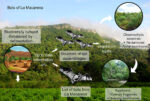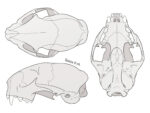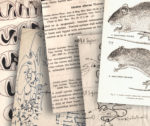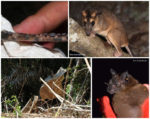Diversity of bats of Sierra de la Macarena with comments on their ecological patterns
Darwin M. Morales-Martínez, Andrés F. Suárez-Castro, Hugo F. López-ArévaloThe Serranía de la Macarena is an outstanding biodiversity hotspot in the western Amazon because it possesses a high diversity due to the influence of several biogeographic regions, a wide elevational range, and high heterogeneity of vegetation. However, knowledge of the bat richness, composition, and structure is precarious and inventories in the area are scarce. We present a list of bat species for La Macarena based on fieldwork campaigns and information from the literature and biological collections. Based on the fieldwork we conducted, we also describe the diversity patterns of bat assemblages from two contrasting vegetation types: rainforest, and chasmophytic savannas. We registered 73 species from seven families, including nine new records for La Macarena. Forty-eight species were recorded in our sampling sites (35 species in rainforest, and 32 in chasmophytic savannas), while 25 species are reported based on scientific literature and museum specimens. We found ecological differences between the assemblages of both vegetation types related to dominance patterns at the species and ensemble levels. Understory frugivores and nectarivores were the dominant groups in chasmophytic savannas and accounted for 82% of the captures, whereas the canopy frugivores were the most abundant in the rainforest (52%). The differences observed in diversity patterns between both types of assemblages could be associated with highly contrasting vegetation structures and the absence of essential feeding items in chasmophytic savannas. We highlight the need to conduct surveys in new areas to fill the gaps in our knowledge of diversity in this important biodiversity hotspot.
Diversidad de murciélagos de la Serranía de la Macarena, con comentarios sobre sus patrones ecológicos. La Serranía de la Macarena es un punto caliente de biodiversidad en la Amazonía occidental, ya que posee una alta diversidad, producto de la influencia de varias regiones biogeográficas, un amplio rango altitudinal y una alta heterogeneidad de la vegetación. Sin embargo, el conocimiento de la riqueza de especies de murciélagos, su composición y estructura es precario y los inventarios en esta área son escasos. Presentamos una lista con las especies de murciélagos para La Macarena basados en expediciones de campo e información proveniente de literatura científica y colecciones biológicas. Además, describimos los patrones de diversidad de dos ensamblajes de murciélagos en dos tipos de vegetación: bosques húmedos y sabanas casmófitas. Presentamos un total de 73 especies de siete familias, entre las que se incluyen nueve nuevos registros para La Macarena. Hemos registrado 48 especies en campo (35 en bosques húmedos y 32 en sabanas casmófitas), mientras que 25 provienen de registros de la literatura científica y especímenes de colección. Hemos encontrado diferencias ecológicas entre los ensamblajes de ambos tipos de vegetación resumidos en los patrones de dominancia a nivel de especie y de ensambles. Los frugívoros de sotobosque y los nectarívoros fueron los grupos dominantes en las sabanas casmófitas, con el 82% de las capturas, mientras que el grupo de los frugívoros de dosel fue el más abundante en bosques húmedos (52%). Las diferencias observadas en los patrones de diversidad de los ensamblajes pueden estar asociadas con las diferencias contrastantes en la estructura de la vegetación y la ausencia de ítems alimenticios en las sabanas casmófitas. Resaltamos la necesidad de dirigir más exploraciones en nuevas áreas para subsanar los vacíos en el conocimiento de la riqueza de este punto caliente de biodiversidad.



